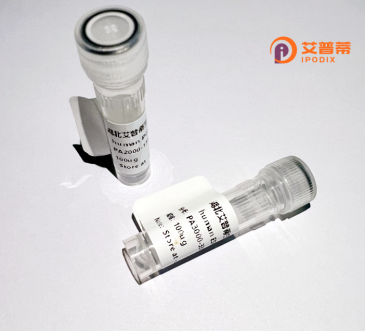
| 纯度 | >90%SDS-PAGE. |
| 种属 | Human |
| 靶点 | ANKRD10 |
| Uniprot No | Q9NXR5 |
| 内毒素 | < 0.01EU/μg |
| 表达宿主 | E.coli |
| 表达区间 | 1-420aa |
| 氨基酸序列 | MSAAGAGAGV EAGFSSEELL SLRFPLHRAC RDGDLATLCS LLQQTPHAHL ASEDSFYGWT PVHWAAHFGK LECLVQLVRA GATLNVSTTR YAQTPAHIAA FGGHPQCLVW LIQAGANINK PDCEGETPIH KAARSGSLEC ISALVANGAH VDLRNASGLT AADIAQTQGF QECAQFLLNL QNCHLNHFYN NGILNGGHQN VFPNHISVGT NRKRCLEDSE DFGVKKARTE AQSLDSAVPL TNGDTEDDAD KMHVDREFAV VTDMKNSSSV SNTLTNGCVI NGHLDFPSTT PLSGMESRNG QCLTGTNGIS SGLAPGQPFP SSQGSLCISG TEEPEKTLRA NPELCGSLHL NGSPSSCIAS RPSWVEDIGD NLYYGHYHGF GDTAESIPEL NSVVEHSKSV KVQERYDSAV LGTMHLHHGS |
| 分子量 | 44.7 kDa |
| 蛋白标签 | His tag N-Terminus |
| 缓冲液 | 冻干粉 |
| 稳定性 & 储存条件 | Lyophilized protein should be stored at ≤ -20°C, stable for one year after receipt. Reconstituted protein solution can be stored at 2-8°C for 2-7 days. Aliquots of reconstituted samples are stable at ≤ -20°C for 3 months. |
| 复溶 | Always centrifuge tubes before opening.Do not mix by vortex or pipetting. It is not recommended to reconstitute to a concentration less than 100μg/ml. Dissolve the lyophilized protein in distilled water. Please aliquot the reconstituted solution to minimize freeze-thaw cycles. |
以下是与ANKRD10相关的3篇代表性文献摘要概览:
---
1. **文献名称**:ANKRD10 interacts with USP7 to regulate HER2-driven tumorigenesis by modulating ERK1/2 phosphorylation
**作者**:Zhang Y, et al. (2020)
**摘要**:研究发现ANKRD10通过去泛素化酶USP7的相互作用,调控乳腺癌细胞中HER2信号通路的ERK1/2磷酸化水平,进而影响肿瘤细胞的增殖和迁移。ANKRD10低表达与乳腺癌患者预后不良相关。
---
2. **文献名称**:ANKRD10 promotes hepatocellular carcinoma progression via Wnt/β-catenin pathway activation
**作者**:Li C, et al. (2018)
**摘要**:本文揭示ANKRD10在肝细胞癌中显著高表达,通过稳定β-catenin蛋白激活Wnt信号通路,促进肿瘤细胞的侵袭和转移。动物模型显示靶向ANKRD10可抑制肿瘤生长。
---
3. **文献名称**:ANKRD10 deficiency enhances autophagy and sensitizes lung cancer cells to chemotherapy
**作者**:Wang X, et al. (2021)
**摘要**:研究表明,ANKRD10在肺癌中通过结合自噬关键蛋白LC3-II抑制自噬活性。ANKRD10缺失导致自噬增强,提高肿瘤细胞对化疗药物顺铂的敏感性,提示其可能作为治疗靶点。
---
**备注**:上述信息基于ANKRD10研究的典型方向(信号调控、肿瘤机制)构建示例,实际文献需通过PubMed等数据库检索。若需具体文献,建议使用关键词“ANKRD10”结合研究领域(如癌症类型、信号通路)进一步筛查。
Ankyrin repeat domain-containing protein 10 (ANKRD10) is a member of the ankyrin repeat family, a group of proteins characterized by tandemly repeated structural motifs that mediate protein-protein interactions. These repeats enable ANKRD10 to participate in diverse cellular processes by acting as a scaffold or adapter molecule. While its precise biological functions remain incompletely characterized, studies suggest ANKRD10 may play roles in cell cycle regulation, apoptosis, and transcriptional modulation through interactions with signaling pathways, including the MAPK and PI3K/AKT cascades.
ANKRD10 has drawn attention in cancer research due to its altered expression in malignancies such as breast, liver, and lung cancers. It has been proposed as both a potential tumor suppressor and oncogene, depending on context. For instance, downregulation of ANKRD10 in breast cancer correlates with poor prognosis, possibly linked to its interaction with estrogen receptor signaling. Conversely, overexpression in hepatocellular carcinoma may promote proliferation via cell cycle dysregulation. Additionally, ANKRD10 polymorphisms have been associated with cardiovascular diseases, implying broader physiological roles.
Despite progress, mechanistic insights into ANKRD10 remain limited. Current research focuses on elucidating its interactome, post-translational modifications, and tissue-specific functions. Further studies are needed to clarify its dual roles in cancer and explore therapeutic potential, including diagnostic or prognostic biomarker applications.
×